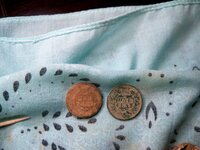Nana40
Gold Member
I found this neat coin last week. I posted it on FB and Thom says he thinks it's a double strike. I know nothing about it other than that. I don't even dare try to clean it. Any further comments are more than welcome on it.  The other Indian cent I dug the same day....different hole. It's 1906.
The other Indian cent I dug the same day....different hole. It's 1906.
Thanks a bunch,
Nana


 The other Indian cent I dug the same day....different hole. It's 1906.
The other Indian cent I dug the same day....different hole. It's 1906.Thanks a bunch,
Nana














 If it's only worth $300, if it were to be a double strike, the only thing I have to lose is the fact that it was a neat find, huh....and MM's plane ticket to Bama and his Ruth's Chris meal.
If it's only worth $300, if it were to be a double strike, the only thing I have to lose is the fact that it was a neat find, huh....and MM's plane ticket to Bama and his Ruth's Chris meal. 







